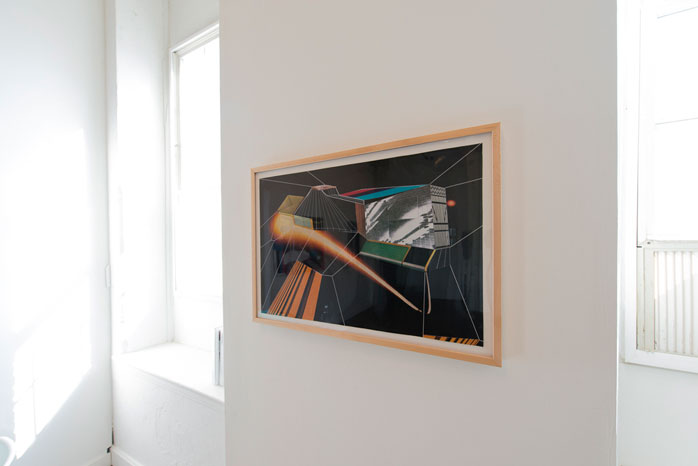FJORD & TSA: “A City(ies) That Walked”
The Form Review is a simple attempt to increase dialogue within art journalism and highlight the subjectivity of a traditional exhibition review. Artists/curators/responsible parties of an exhibition are invited to respond to five short prompts. In turn, a representative of the St.Claire views the exhibition and independently responds to the same five prompts. Both sets of “form answers” are published in tandem on the St.Claire website. To participate drop us a line at hark@the-st-claire.com
 (IMAGE: Courtesy of the Tiger Strikes Asteroid)
(IMAGE: Courtesy of the Tiger Strikes Asteroid)
 Responses by Rubens Ghenov, Curator
Responses by Rubens Ghenov, Curator
1. What is hidden in this exhibition? What is in plain sight?
Hidden: A city(ies) that walked
Plain sight: The or (an) Archigram Space Program.
2. Who would be this exhibition’s parents? What might it’s children look like?
Parents: Peter Cook, David Greene, Warren Chalk, Dennis Crompton, Ron Herron and Michael Webb. Plus big ups to Theo Crosby.
Children: This is an interesting point to pursue and perhaps most pivotal to the exhibit due to the show being minded on parent/children’s relationships. These children should be noted. The artists in the show represent some of the parents’ children, pupils or illegitimate offspring. These are alphabetically surnamely: Ricky Allman, Elizabeth Blau, Jacob Feige, Cooper Holoweski, Greg Kalliche, Todd Keyser, Justin Michelll, Letha Wilson, Kevin Zucker and the Artist as Tourist Collective consisting of (Ann Cleary, Brigid McCaffrey, Jane Parrott, Jess Perlitz and Jessica Segall). Not exhibited, Sarah Oppenheimer.
The Exhibition’s Children may look like: Autechre’s Amber (with the pitch at – 2) laced with The Zombies, Carlos Diegues’ Bye Bye Brazil meets Kubric’s 2001: A Space Odyssey (minus actors), if Apichatpong Weerasethakul’s Uncle Boonmee Who Can Recall His Past Lives were filmed in a set consisting of a favela made a la Schwitters’ Merzbau in Dubai furnished with Louis Kahn’s secret line of Merzbau inspired concrete furniture, Korakrit Arunanondchai’s work sans denim and if Abraham Cruzvillegas, B. Wurtz and Agnes Martin had a design firm and were hired by Fassbinder in 2073 to make posters for World on a Wire.
3. Describe one moment in this exhibition.
A right to left swoop of a yellow orthogonal-like ray that travels across the brick wall to the adjacent white, carried by the guidance of a light blue partner named Michell(e) Z. Wilson.
4. This exhibition answers the following question:
Good morning class, give me one example of the Cézannic Chair Effect Theory?
5. You should message this exhibition if…
you happen to have any connection to the parents
 Responses by Stephanie Bursese, Editor The St.Claire
Responses by Stephanie Bursese, Editor The St.Claire
1. What is hidden in this exhibition? What is in plain sight?
You can see a lot of paint. You can see a lot of lines. You can see these smoke- covered colored landscapes, parts of landscapes, remnants of landscapes-sliced off and stuck in the corner. Or cut into a neat little cone/cube/cylinder. Everything has been trimmed, neatly. You can’t see, but feel, the thick cloud of intimidation. It hangs in between the prints and sculptures. It’s with you when you travel between Tiger Strikes Asteroid and Fjord. It stinks-like, someone thought about this show for a long time. They combed and picked through work. They actually started with an idea. It’s been about 50 years since Archigram published their first issue of a magazine devoted to theoretical architectural designs. They were often beautifully irrational. Much like this exhibition, they were intimidating in their palpable genius and reeking of a dislocation with reality.
2. Who would be this exhibition’s parents? What might it’s children look like?
Rebar and Kraftwerk. Kate Steciw could be part of an estranged child custody battle.
3. Describe one moment in this exhibition.
I was standing, facing the little dark video cove in the archway behind the desk at Tiger Strikes Asteroid. I was watching Cooper Holoweski’s video. There’s a part where pieces of paper/computer/animation start to form a human foot and it builds itself with invisible hands. It looks like a ball of colored tape or a birds nest, wrapping around itself and collecting material along the way. First a foot and then a leg and then a thigh. It was one of those macro-micro moments where you can see how everything is built, shockingly. All of the pieces of people and buildings and life are all the same things, built slowly, thing by thing. It makes you feel insignificant and you try to look at something else- the edge of the projection or a crack in the paint on the doorframe- and you feel ok again.
4. This exhibition answers the following question:
Given the rapid turn around time of Philadelphia’s small, independently run gallery circle, can a curated group exhibition operate as both a tightly woven aesthetic experience and contain a solid, smart, layered conceptual foundation that actually resonates?
5. You should message this exhibition if…
You want to get cut.
…
“A City(ies) That Walked, The Archigram Space Program”
Curated byRubens Ghenov and Cooper Holoweski
ON VIEW:
September 6 – September 29, 2013
Tiger Strikes Asteroid
319A North 11th Street, Suite 2H
Philadelphia PA
philadelphia.tigerstrikesasteroid.com/
FJORD Gallery
2419 Frankford Ave.
Philadelphia PA
www.fjordspace.com/
